
Muntiacus puhoatensis
Muntiacus puhoatensis,Puhoat Muntjac,Przewalski's muntjac
The scientific name of the Puhoat Muntjac is Muntiacus puhoatensis, and its ···

Muntiacus montanus
Muntiacus montanus,Sumatran Muntjac
The scientific name of the Sumatran Muntjac is Muntiacus montanus, and its f···

Muntiacus vuquangensis
Muntiacus vuquangensis,Giant Muntjac, Giant Barking Deer
The Vietnamese giant muntjac, scientifically known as Muntiacus vuquangensis···

Muntiacus atherodes
Muntiacus atherodes,Bornean Yellow Muntjac、Bornean Yellow Muntjack,Tufted Deer
The scientific name of the Bornean Yellow Muntjac is Muntiacus atherodes, an···

Muntiacus reevesi
Muntiacus reevesi,Chinese Muntjak,Formosan Reeves' Muntjac、Reeve’s Muntjac、Reeves's Muntjac,Mountain barking deer, dog muntjac, horned muntjac, yellow muntjac, mountain muntjac
Muntiacus reevesi (scientific name: Chinese Muntjak, Formosan Reeves' Mu···
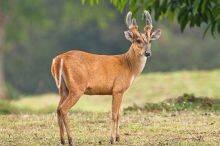
Muntiacus muntjak
Muntiacus muntjak,Bornean Red Muntjac,Indian muntjac, Borneo red muntjac, red muntjac, southern red muntjac, barking deer, yellow muntjac
Red Muntjac (scientific name: Muntiacus muntjak) is also known as Bornean Re···

Muntiacus feae
Muntiacus feae,Fea's Muntjac、Forest muntjac,Wood muntjac, black muntjac, Fischer's muntjac
Fea's Muntjac (scientific name: Muntiacus feae) is also known as Fea'···
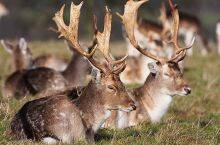
Dama dama
Dama dama,Fallow Deer
Fallow Deer (scientific name: Dama dama) has two subspecies.Male fallow deer···

Dama mesopotamica
Dama mesopotamica,Mesopotamian Fallow Deer、Persian Fallow Deer,Mesopotamian fallow deer, Mesopotamian deer
The scientific name of the Persian fallow deer is Dama mesopotamica, and its···

Rucervus duvaucelii
Rucervus duvaucelii,Barasinga、Swamp Deer,Indian Swamp Deer, Swamp Deer
Barasinga (scientific name: Rucervus duvaucelii) is also known as Barasinga ···
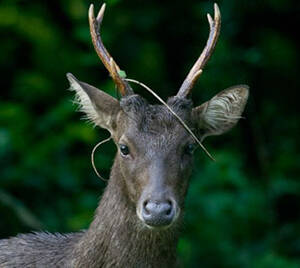
Rusa timorensis
Rusa timorensis, Javan Deer、Javan Rusa、Rusa、Rusa Deer、Sunda Sambar、Timor Deer, Cerf de Timor, Sambar de Java, Mähnenhirsch,Javan Deer, Javan Sambar, Timorese Deer
Rusa timorensis (scientific name: Javan Deer, Javan Rusa, Rusa, Rusa Deer, S···

Rucervus schomburgki
Rucervus schomburgki ,Su's deer, white-hipped deer, Siamese deer
Schomburgki (scientific name: Rucervus schomburgki) is a species of deer nat···

Rusa alfredi
Rusa alfredi,Philippine Spotted Deer,Prince Alfred’s Spotted Deer,Visayan Spotted Deer,Prinz-Alfred-Hirsch,Philippine sika deer, Visayan sambar deer, Visayan spotted deer, Visayan sika deer, Acheron&#
Philippine sambar deer (scientific name: Rusa alfredi) English Philippine Sp···

Axis calamianensis
Axis calamianensis,Kashima spotted deer, Kashima hog deer
The Calamian Hog Deer (Axis calamianensis) is one of three species of deer n···
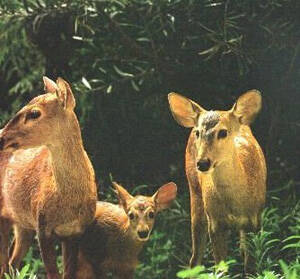
Axis kuhlii
Axis kuhlii
The Ba Island spotted deer (Axis kuhlii) is a deer endemic to the Indonesian···

Cervus axis
Cervus axis,Uŋpȟáŋ Glešká,Hupah Glešká,Spotted deer, white deer
The scientific name of the spotted deer, Cervus axis or Axis axis, is active···

Okapia johnstoni
Okapia johnstoni,Okapi
Okapi (scientific name: Okapia johnstoni) is called Okapi in English. At fir···
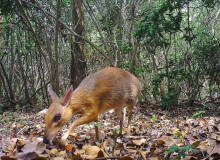
Tragulus versicolor
Tragulus versicolor,Silver-backed Chevrotain,Vietnamese Mousedeer, Chevrotain du Vietnam,Silver-backed chevrotain, Vietnamese mouse deer
Vietnamese Mousedeer (scientific name: Tragulus versicolor) English Silver-b···

Tragulus nigricans
Tragulus nigricans, Balabac Mouse Deer,Balabac Chevrotain,Philippine Mouse-deer, Chevrotain de Balbac
Philippine Mouse Deer (scientific name: Tragulus nigricans) English Balabac ···

Tragulus napu
Tragulus napu,Greater Oriental Chevrotain、Balabac Chevrotain、Greater Indo-Malayan Chevrotain、Greater Mousedeer,Larger Malay Chevrotain,Larger Mousedeer,Napu,Chevrotain napu, Grand tragul malais, Napoh
The Greater Mousedeer (scientific name: Tragulus napu) is called Greater Ori···

Tragulus kanchil
Tragulus kanchil,Lesser Oriental Chevrotain、Lesser Indo-Malayan Chevrotain、Lesser Malay Chevrotain、Lesser Mousedeer、Mouse Deer, Chevrotain kanchil, Petit tragul malais, Kanchil
Lesser Mousedeer (scientific name: Tragulus kanchil) English Lesser Oriental···
